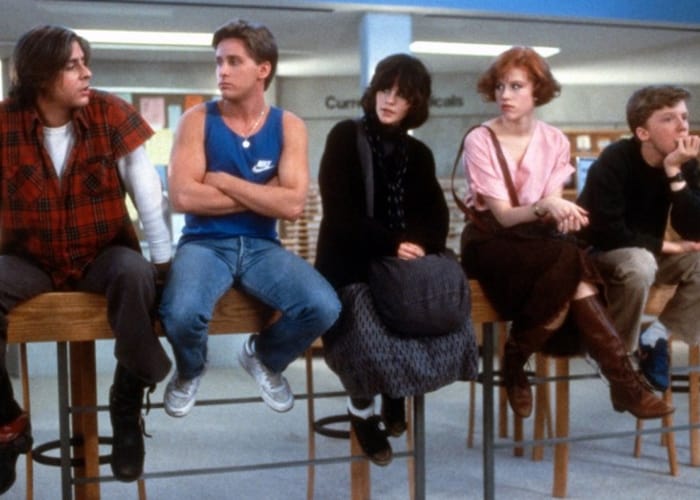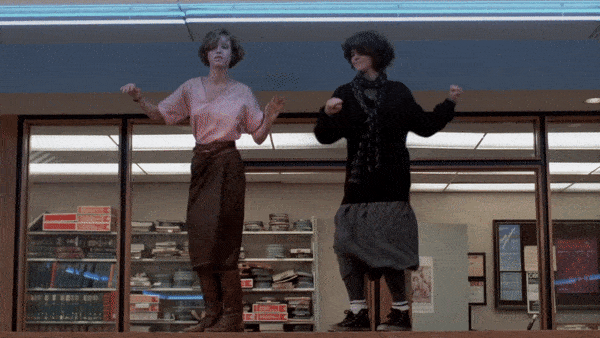
John Hughes wasn’t much of a name yet in 1985 when The Breakfast Club was released, but it was already clear that he was one to watch. His scripts for Mr. Mom and National Lampoon’s Vacation had resulted in box-office hits, and while his own directorial debut ‐ Sixteen Candles ‐ wasn’t as immediately beloved it showed the mash-up of affection and wit that would become his trademark.
The Breakfast Club has its detractors, but for most viewers the film offers even a minor glimpse back to their teen years. Not everyone fit into these specific five molds ‐ the athlete (Emilio Estevez), the princess (Molly Ringwald), the criminal (Judd Nelson), the brain (Anthony Michael Hall) and the basket case (Ally Sheedy) ‐ but there’s an honesty here even within the characterizations.
The film was re-released onto Blu-ray earlier this month with a remastered picture and additional extras including a previous commentary track with Nelson and Hall. The two reminisce about the production, express their love for Hughes and the fellow cast and crew and make plans to hang out more. Oh, and Hall also makes sure to remind Nelson that he recently starred in Christopher Nolan’s The Dark Knight.
Keep reading to see what I heard on the commentary track for The Breakfast Club.

now go watch some video essays!
The Breakfast Club (1985)
Commentator: Anthony Michael Hall and Judd Nelson (actors), Jason Hillhouse (dvd feature producer)
1. The BMW that Claire (Ringwald) arrives in belonged to Hughes. “The guy with the red hair and Burberry scarf we have no explanation for,” jokes Hall.
2. The woman in the car with Brian (Hall) are Hall’s actual mother and little sister.
3. The library in which the kids serve their detention is part of an actual school, but it’s not a library ‐ it was a gymnasium that the film’s art department completely made over. A local football team, the Chicago Blitz, had been using the room for practice, but the production required they move outside. “They hated us,” says Nelson.
4. Both actors share their love for the late Paul Gleason with Hall adding “He had two favorite topics, Mickey Mantle and Bob Dylan. We would always talk about one or the other.”
5. Nelson had improv’d the bit where he spits a “loogie” into the air and catches it back in his mouth during rehearsal, and Hughes loved how much it grossed out Ringwald so he added it to the scene.
6. Both actors recall the film being the first and last time the cast of a film they were a part of was given ample rehearsal time on set before shooting.
7. Hillhouse comments on John’s (Nelson) immediately anarchic presence when entering the library. “I’m the one guy actually encouraged to break the rules,” Nelson explains. “Also I’m the one character who’s been there before so it gives my character a certain advantage to move more freely through the space.”
8. Nelson recalls being surprised how much Hall grew during production. “When we first auditioned I was probably maybe two inches taller than him,” says Nelson. “When we started rehearsals I was maybe half an inch taller than him. By the end of the movie Michael was taller than I was, and I’d already begun writing letters to geneticists.”
9. Hall and Ringwald were the only two of the five who had to attend actual classes during production.
10. The bandana on John’s boot was Nelson’s idea.
11. John’s locker was decorated by the art department, but Nelson made some edits including the decision to pull a photo of Hall & Oates.
12. The hallway montage where the kids try to avoid Vernon (Gleason) strikes them as a combination of M.C. Escher and Scooby-Doo in the way the angles, near-misses and obvious playfulness lacks any semblance of logic.
13. The scene where the five are sitting on the floor in a circle discussing sex leads Hall to recall that Hughes would “be sitting there on the floor with us.” They both share positive memories of Hughes’ directorial style which consisted of him being involved with the actor as a true collaborator. “I just found him very encouraging,” says Nelson, “as a person and a director.”
14. They point out that while the dance scene montage feels cliched these days for an ’80s teen flick it actually feels earned here. It comes immediately after the film’s heaviest scene with Andrew (Estevez) and Brian both sharing their most personal moments, and it gives both the audience and the characters a cathartic break.
15. Hughes cameos at the end as Brian’s father.
Best in Commentary
- Hall: “Molly was hot. She had kind of an old lady do-hair, but I like it.”
- Nelson: “He [Paul Gleason] was always great to hate.”
- Hillhouse: “That’s the greatest ‘Fuck you!’ in cinema history.”
- Nelson: “Michael [Hall] meanwhile is now 25 inches taller than us. Under no circumstances could Emilio and I together break him.”
Final Thoughts
Both Hall and Nelson had busy years in 1985 as the former followed up The Breakfast Club with Weird Science (also written/directed by Hughes) and the latter starred in St. Elmo’s Fire (where he played a college graduate). They’ve had wildly different careers since then, but both make it clear on the commentary that their time with Hughes and on this film was some of the best of their lives (and careers). The track leans more playful and complimentary than it does informative, but the two make it a fun listen with their banter and shared laughter.
Check out more commentary commentary in the Commentary Commentary archives
Related Topics: Commentary Commentary
